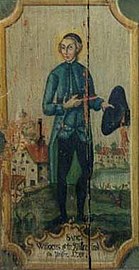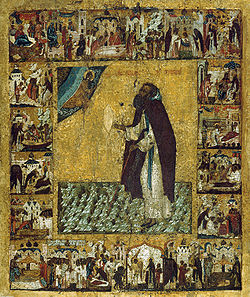Top Qs
Timeline
Chat
Perspective
November 6 (Eastern Orthodox liturgics)
From Wikipedia, the free encyclopedia
Remove ads
November 5 - Eastern Orthodox liturgical calendar - November 7

All fixed commemorations below celebrated on November 19 by Eastern Orthodox Churches on the Old Calendar.[note 1]
For November 6th, Orthodox Churches on the Old Calendar commemorate the Saints listed on October 24.
Saints
- Virgin-martyr Manatho.[1] (see also: October 20)
- Virgin-martyrs Tecusa, Alexandra, Claudia, Matrona, Polactia, Euphrosyne, Julia, Euphrasia, Faina, and Athanasia, of Ancyra (303)[2][3][4] (see also: May 18)
- Martyr Nikander, by the sword.[5][6][note 2]
- Saint Paul the Confessor, Archbishop of Constantinople (c. 350)[2][3][4][6][7][8] (see also: June 7 - West)
- Venerable Luke of Tauromenium, monk, of Sicily (820)[2][3][4][6][9][10]
- Saint Demetrianus, Bishop of Cytheria on Cyprus, Wonderworker (c. 915)[2][3][6][11][note 3]
- Blessed Paul of Corinth, Fool-for-Christ.[6][12][note 4]
Remove ads
Pre-Schism Western saints
- Saint Felix of Thynissa, a martyr who suffered in Thynissa near Hippo (Bone) in North Africa.[13][note 5][note 6]
- Saint Illtyd (Illtut), abbot, of Llanilltyd Fawr, Wales (505)[2][3][13][15][note 7]
- Saint Leonard of Noblac, Gaul (c. 559)[2][3][13][note 8][note 9]
- Saint Leonianus, a hermit near Autun (c. 570)[13][note 10]
- Saint Felix, a monk at a monastery in Fondi in the south of Italy (6th century)[13][14]
- Saint Severus, Bishop of Barcelona in Spain (633)[13][note 11][note 12]
- Saint Edwen, she is the patron saint of Llanedwen in Anglesey in Wales (7th century)[13]
- Saint Efflamm, born in Britain, he went to Brittany where he became abbot of a monastery he had founded (c. 700)[13]
- Saint Winnoc, Abbot, of Flanders (716)[2][3][13][16][note 13][note 14]
- Saint Cowey of Portaferry, Abbot, of Moville Monastery (8th century)[2][3]
- Saint Erlafrid, founder of Hirsau Abbey in Germany, where he became a monk (c. 830)[13]
- Saint Stephen of Apt, Bishop of Apt in the south of France in 1010 (1046)[13]
Remove ads
Post-Schism Orthodox saints
- Venerable Barlaam of Khutyn, founder of Khutyn Monastery, Novgorod (1192)[2][3][4][6][17][18][19] (see also: June 6 )
- Saint Luke, steward of the Kiev Caves (13th century)[2][3][4][6][20]
- Saint Herman, Archbishop of Kazan (1567)[2][3][4][19][21]
- Saint Barlaam of Keret, Karelia (16th century)[2][3][4][19][note 15] (see also: January 15 )
- Venerable Agapios the Presbyter (Asimakis Leonardos) (1812)[6][22][note 16]
- Saint Elias Fondaminsky of Paris (1942)[2][3] (see also: July 20 )
New martyrs and confessors
- New-Martyr Gregory the Cross-bearer (1936)[3][23]
- New Hieromartyr Nicetas (Delektorsky), Bishop of Orekhovo-Zuevsk (1937)[2][3][4][19][note 17]
- New Hieromartyr Barlaam (Nikolsky), Abbot, of Andreyevskoe, Moscow (1937)[2][3][4][19]
- New Hieromartyr Gabriel (Vladimirov), Hieromonk of the St. Michael Skovorodsky Monastery, Novgorod (1937)[2][3][4][19]
- New Hieromartyr Gabriel (Gur), Hieromonk, of Lytkarino, Moscow (1937)[2][3][4][19]
- New Hieromartyrs Anatoly Berzhitsky, Arsenius Troitsky,[note 18] Nicholas Dvoretsky, Nicholas Protasov, Constantine Lyubomydrov, Priests (1937)[3][4][19]
- New Hieromartyrs of the Kamensk Diocese (1937):[24]
- Virgin-martyrs Nina (Shuvalova), and Seraphima (Gorshkova), nuns (1937)[3][4][19][23]
- New Hieromartyr Basil Krylov, Priest (1938)[3][4][19]
- Synaxis of the New Martyrs of Sarov:[2][3][23]
- Anatole, Basil, Hierotheus, Isaac, and Rufinus (1938)
Other commemorations
- Abbot Pachomius (1794); Hieroschemamonk Joseph (1785); Hieromonks Pitirim (1789) and Matthew (1795); and Monk Joachim (1802).
Icon gallery
- St. Paul the Confessor, Archbishop of Constantinople.
- St. Illtyd, abbot, of Llanilltyd Fawr, Wales.
- St. Peter and St. Leonard of Noblac.
- St. Winnoc of Flanders.
- Venerable Barlaam of Khutyn.
- St. Herman, Archbishop of Kazan.
- Saint Barlaam of Keret, Karelia.
- New Hieromartyr Nicetas (Delektorsky), Bishop of Orekhovo-Zuevsk.
Notes
- The notation Old Style or (OS) is sometimes used to indicate a date in the Julian Calendar (which is used by churches on the "Old Calendar").
The notation New Style or (NS), indicates a date in the Revised Julian calendar (which is used by churches on the "New Calendar"). - Probably one of the 33 Martyrs of Melitene commemorated in November 7.
- See: (in Greek) Άγιος Δημητριανός. Βικιπαίδεια. (Greek Wikipedia).
- We do not know how he died. We know only that he was from Corinth, and became a standard-bearer.
- He was found dead in prison the day before he was to be executed.
- One of the most famous saints in Wales. He became a monk with St Cadoc and later founded the monastery of Lian-IlItut or Llantwit, from where came most of the Welsh saints of that period. By tradition he reposed in Brittany.
- A French courtier converted by St Remi of Rheims in France. On the advice of that saint, St Leonard went to live in the monastery of Micy near Orleans and later he became a hermit in a neighbouring forest, now called Noblac.
- Born in Pannonia, he was taken as a prisoner to France and on regaining his freedom lived as a hermit near Autun.
- He was martyred under the Arian Visigoths who put him to death by driving nails into his temples.
- Born in Wales, he became a monk at Sithin in France. He was sent to found a new monastery at Wormhoult in Belgium where he became abbot and he enlightened the surrounding area from that centre.
- See also: (in Russian) Варлаам Керетский. Википедии. (Russian Wikipedia).
- Born in Dimitsana in 1740 as Asimakis Leonardos, later known as Agapios the Presbyter. He was an eminent scholar and ecclesiastical writer. He died in Argos in 1812.
- See: (in Russian) Никита (Делекторский). Википедии. (Russian Wikipedia).
- See: (in Russian) Троицкий, Арсений Сергеевич. Википедии. (Russian Wikipedia).
Remove ads
References
Sources
Wikiwand - on
Seamless Wikipedia browsing. On steroids.
Remove ads








